RIPE 90 takes place in Lisbon - the very city where RIPE Labs was first introduced to the community sixteen years ago at RIPE 59. As always, you can view the slides, you can watch the recordings, but if you're wondering what's really happening at the RIPE Meeting, read the daily meeting blog!
Day 5: The coffee miracle
As we wandered to the plenary this morning, we were delighted to find that the rumours of the barista’s absence were greatly exaggerated. So, coffee in hand, we got ready for the last day of RIPE 90 here in sunny Lisbon. Like all of us, our first speaker of the day, Christopher Dziomba of Deutsche Telekom AG, is a BGP enthusiast, as he shared insights on BGP-EVPN and demonstrated how dynamic VRF attachments and instant Layer 2 services can integrate with Kubernetes. Emile Aben of the RIPE NCC then articulated the cognitive dissonance of the Internet, walking us through the Iberian Peninsula power outage on 28 April. Through the RIPE NCC’s RIS (RIPE Routing Information Service), he showed how resilient the Internet remains despite outages, powered not only by electricity but by human efforts and adaptability.
Speaking of human adaptability - access points have reached the RIPE Meeting bathrooms
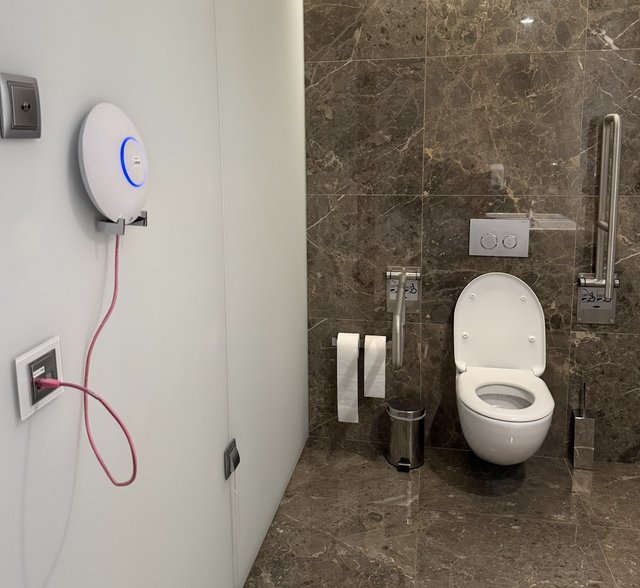
Amedo Beck Peccoz from ESpanix discussed the outage in Spain and Portugal from a different perspective - what happened on the ground and what lessons did they learn? Elevators stopped, logistics went awry, and creative problem-solving was needed urgently, like that one organisation cleverly fueling generators using petrol from employees’ cars. Communication emerged as a crucial lifeline through it all.
The plenary continued discussing outages, but this time we dived under the sea with Emile Aben (again?) and Joaquin Vaquero Ortiz of the RIPE NCC. Again, the Internet showed its resilience during the cable damage in the Baltic Sea. This time, they analysed the effects with RIPE Atlas - shoutout to all RIPE Atlas anchor hosts who help us to show such deep dives into Internet resilience! The session reinforced the Internet’s remarkable ability to endure and adapt, highlighting again that behind every resilient network stands resilient people.
After the announcement of the GM results, we reached the closing plenary. The session opened with the RIPE PC election results. Congratulations to Clara Wade and Amedeo Beck Peccoz, who will continue/commence their tenure on the esteemed committee.
Turning to the session proper, we saw a final few flashes of lightning before the end. Ondřej Surý of ISC - who it seems we can hardly keep off the stage (not that we'd want to, Ondřej) - gave his third talk of the meeting, this time on SIEVE - an eviction algorithm simpler than LRU for web caches. Next, Alex Semenyaka of the RIPE NCC shared his recent discovery that he could install a RIPE Atlas software probe on his Android phone. That’s not going to help our phone addictions, Alex! He also shared some caveats: right now measurements are not supported, and he suggested putting some extra controls in place once they are. Then we heard from Anna Wilson of HEAnet, who followed up on Maria Farrell’s talk from Day 1 (“How to Rewild the Internet”), nicely bookending the theme of rethinking our approach to the Internet and moving away from always scaling up. As Anna said, it’s okay to be smaller, and important to keep fighting to break the Internet out of the tech plantation mould.
We then heard from Rob Lister on behalf of the Code of Conduct Team as he presented the team’s report. Two cases from prior to RIPE 90 have now been resolved, and one new report had been received and now already concluded. He shared voices from the community expressing diverse attitudes towards various incidents and situations encountered in RIPE, and he encouraged people to feel comfortable reaching out to the team if needed.
Then it was time for the presentation we’d all been waiting for - the RIPE 90 Technical Report, this time presented by the RIPE NCC’s Andrea Di Menna, who took the helm coordinating the tech team through a very smooth RIPE Meeting. Fortunately, not too smooth! After all, the number of problems encountered usually correlates to the comedy value when it comes to the tech report, and Andrea did not fail to deliver.
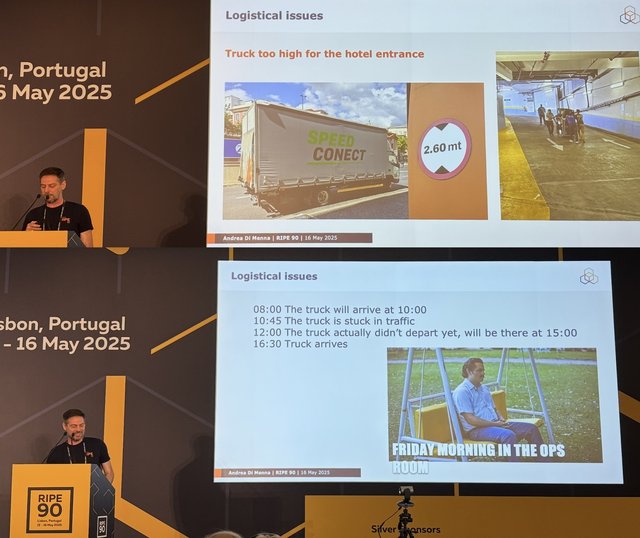
Mirjam Kühne - RIPE Chair extraordinaire - then stepped up to *officially* close the meeting, sharing attendee stats, waving to the local hubs, and giving thanks to everyone who helped make RIPE 90 so very successful and just so much fun! And of course, a shoutout for our next big outing at RIPE 91, which will take place in Bucharest, Romania in October. We hope to see you there! Eric Andrei Băleanu of the RIPE 91 local host, InterLAN-IX, then stepped up to say a few words about what we can look forward to at RIPE 91.

And then there was an entirely unexpected, *unofficial* closing of the meeting… but we’re keeping that bit secret.
Day 4: The bright, bright lights of RIPE 90

IPv6 WG: IPv6 sometimes < mostly < always!!
The IPv6 WG session commenced with the chairs glad to see that a certain notorious Wednesday evening BoF had thankfully drawn to a close in time. Maynard Koch opened the talks with a call to fix router configurations, which was an extension of the lightning talk he gave on Tuesday during the plenary session. He explained how a single ICMP Echo request could turn into a flood of Hop Limit Exceeded replies (more than 250K!). After confirming there was a bug in routers from a specific brand, Maynard reached out to network operators for which they saw routing loops. This campaign was a success with a decrease of 7.7M routing loops overall and 134 ASes now routing-loop free!
A change in the agenda saw Ondřej Caletka being invited to the stage while the technical team rushed to get his slides up on the screen. Ondřej - sporting an “IPv6 Act Now” t-shirt - talked about the RIPE NCC’s efforts to get their internal services running fully on IPv6. They encountered challenges on the road: some of which they could work on; some that turned out to be outside of their control. But hopes were revived by a great suggestion from Jen Linkova who gave extra motivation to Ondřej to get back at it after the RIPE meeting.
Next up, Fernando Gont’s presentation on IPv6 Support for Multiple Routers, Multiple Interfaces, and Multiple Prefixes went over different scenarios showing issues with multi IPv6 deployments. Judging by the extensive questions and comments raised by the audience, multi-IPv6 has a long life ahead.
Looping on Ondřej’s presentation, Éric Vyncke and Warren Kumari gave their takeaways on IPv6-mostly experiences at industry events, namely CISCO Live in Amsterdam and IETF 122 in Bangkok. Despite unexpected issues like NAT64 pool exhausting or macOS ssh incompatibilities (both fixed on the spot), these events showed IPv6-mostly can be done with the right people in the team.

Connect WG: Spoiler -- the juice is worth the squeeze
Meanwhile, in the side room: there's nothing quite like a bracing Connect session first thing on a Thursday RIPE Meeting morning! Leo Vegoda got us started with a quick update on all the good work that's been going on over at PeeringDB of late. Next up, Marta Burocchi presented on setting up a secure test environment for an IXP. Fed up of watching everything break after that one tiny change you made to your production configuration? Well, fret no more! Namex has come up with a secure pre-production environment that mirrors the peering LAN so you can test your services before you deploy. Joining Marta on the stage was Lorenzo Ariemma who talked more about Kathará, the network emulator behind this and many other research projects.
Greg Hankins talked about migrating an IXP from VPLS to EVPN, a move that helps resolve a variety of issues including outdated VPLS, uneven traffic distribution, and sudden spikes in BUM - for the acronym lovers, that's 'Broadcast, Unknown unicast, Multicast' - traffic.
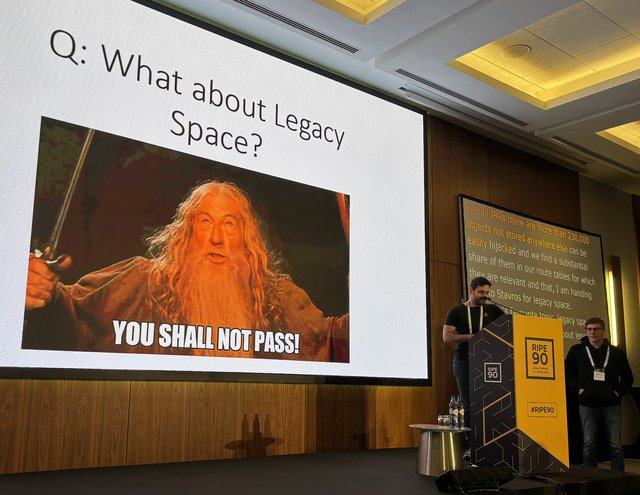
Last up, Stavros Konstantaras invited Matthias Wichtlhuber to join him on stage to present a thorough, revealing analysis of the IRR landscape. They set out to answer such fundamental questions as: do authoritative IRRs represent operators better than third part IRRs? What about legacy space? And of course: is the juice, or is the juice not, worth the squeeze? The findings certainly piqued the interest and appreciation of the WG, with many in the room taking to the mic to thank the presenters for their hard work.
Database WG: Plans, proposals, and pleasant surprises
Over in the Database WG, Ed Shryane (of RIPE NCC’s Database team) talked about the work being done on API Keys authentication (available since January) and MD5 hashed password (plans underway to remove support for MD5 hashed passwords by end of 2025). Also, Ed is looking for community input on 2 topics: a RIPE-NONAUTH Proposal and the introduction of UTF-8 in the RIPE Database.
Ed was followed by his colleague, Adonis Stergiopoulos who introduced OAuth 2.0, a standard designed to access resources hosted by other web apps on behalf of a user. Phase one of the recommended solution - Authorisation Code Flow (with PKCE) - will be delivered in mid-2025.
Randy Bush was called to the mic by William to present (to his surprise!) on work currently being done in the IETF by him and others around publishing End-Site prefix lengths. The WG ended with a round of applause for William Sylvester who is stepping down as WG co-chair after a whopping 17 RIPE Meetings at the helm. David Tatlisu and Peter Hessler remain as co-chairs.
Open Source WG: BIRD, BIND, and the humble scribe
Vicky Risk kicked-off the Open Source WG by sharing some experiences from ICS with funding their development work. If two (2) people making monthly donations of $20 each is not enough to fund their operations, what’s the best approach? She explored some of the benefits and limitations of various approaches they’ve tried in the past.
Next up, Ondřej Surý presented on his work making BIND, which comes from 1998, work faster. Here I need to level with you community, this humble scribe had no idea what any of this was about. However, from the reaction in the room, it was great work!
Maria Matejka then shared something more understandable to a non-technical plebeian such as myself, sharing her experiences building a development team for BIRD. Part of this was about learning to accept that junior developers will not be as good as you, will require time to learn, and probably shouldn’t be put to work serving tea or handling admin. Luckily, given enough time, they will probably gain skills, become more valuable and so on.
Lastly, Martin Stiemerling introduced “yet another SDN controller” but with a twist: it’s built for education, not just experimentation. Tired of wrestling with 400k lines of undocumented legacy, he and his team built a clean, well-documented, model-driven controller from scratch. It’s SDN that students can actually learn from and maybe even improve without crying.
Routing WG: Go Krazy for RPKI
Tim Bruijnzeels gave a short update on the new RPKI functionality at the RIPE NCC. One small but very useful feature is the ability to revert the ROA configuration to a previous state. While I had forgotten about the rsync CVE drama in February, Simon Leinen did not. He brought back memories from a quite scary week for everyone running an RPKI validator. When the vulnerabilities popped up, everyone realised that the vulnerabilities affected the sole common rsync server implementation, and the most used rsync client. Simon made "gokrazy" fit for RPKI.
Finally, Alexander Azimov did not present on ASPA. Instead, he explained the design of a nearly stateless L4 loadbalancer that they deployed (before a DPDK implementation replaced it). It had one big benefit - no need for application changes!
Cooperation WG: This resilient Internet
In Cooperation, first we were treated to a presentation by Christoph Mertens and Améedée Von Moltke, co-chairs of the BEREC Open Internet Working Group. They shared BEREC’s report on IP interconnection. Not much had changed since their last report, but it turns out there’s one thing that hasn’t gotten more expensive these days - the costs of Internet traffic have actually decreased, even as the amount of traffic has increased, due to higher competition and technological development. More of that, please!
Next, there was a series of talks covering Internet resilience in light of recent outages of various sorts. Retired Commander Olli Peltonen of Copoy Oy spoke about bad things that happen when dragging anchors and Internet cables meet, as they have been all too frequently of late in the Baltic Sea. He stressed the importance of being prepared for more events like this and suggested solutions like cable-repairing submarine robots (sci-fi’s not so fi anymore).
Emile Aben followed, presenting the RIPE NCC research team's take on the cable cuts. Main message: despite the damage done, the Internet proved to be remarkably resilient. This theme was picked up by Cloudflare’s David Belson, who looked at the effects of the recent power outage in Portugal and Spain. While there was a clearly negative impact on download speeds and latency, remarkably not all networks went down, as some relied on other sources of power (maybe we should invest in that generator after all…).
We then heard from Rüdiger Martin and Goran Milenkovic of the European Commission, who proposed a new multistakeholder forum for Internet standards deployment. While the idea is still in the conceptual stages, they shared their plans so far, which included four workstreams: network layer communication protocols, email security protocols, DNS security and Internet routing. The ultimate goal is to produce a final set of guidelines by the end of Q2 2027. We love a good multistakeholder forum, so we’ll keep an eye on this one.
Last, Chafic Chaya presented about the RIPE NCC’s engagement in the Middle East with governments and regulators. He shared the different ways the RIPE NCC interacts with Internet stakeholders in the region and demonstrated the effectiveness of the work here; for instance, several Middle Eastern countries showed a significant increase in RPKI adoption following some of our face-to-face trainings.
RIPE Community Plenary: Caffeinate creatively folks!
Mirjam opened the plenary with a mix of updates, election news, and heartbreak: yes, the rumours are true… there will be no barista coffee tomorrow morning! We’ll all be forced to engage with hotel coffee or explore the café wilderness beyond the venue (left out of the hotel, bring a compass). On the bright side, the day starts at 9:30am, so there’s time to caffeinate creatively.
Next up, Hervé Clément returned to the mic like the sequel you didn’t realise you needed: ICP-2: The Feedback Strikes Back. Rather than rehash what the document is (you’ve heard it thrice already), he gave a sharp rundown of what the RIPE 90 crowd actually said about it, and spoiler: you had thoughts. Hervé promised feedback would be taken back to the NRO NC, and that a second draft will land before year’s end. Also, if you haven’t read the draft, do it now. Preferably with caffeine, while supplies last.
Jan Zorz took the mic next with an update from the RIPE Chair NomCom. Jan encouraged everyone to swing by and chat in the NomCom office - a surprisingly productive space next to the children's daycare and noted the confidentiality of all feedback shared: “What’s said in the office, stays in the office.”
Thomas Holterbach from the University of Strasbourg introduced bgproutes.io, a new next-gen BGP route collection platform which launched just a few days ago. Want to have a look? Visit bgproutes.io.
Last up Phillip Oldham from the RIPE NCC gave us a quick update of the new RIPE Meeting website platform and, unlike most tech announcements, you don’t need to do anything. Phill’s team, responsible for all things web at RIPE NCC, has been busy and the new platform is faster, safer, more accessible - with fewer hackers being able to poke around any outdated plugins. One key change is the old call-for-presentations tool which is being retired and replaced with Pretalx, an open-source tool now coming to a RIPE Meeting near you. RIPE 91’s site is already live on the new platform, and the first test of Pre-Talks will go live in a few weeks. So far, it’s looking good but as always, your feedback makes it better. If something breaks (or just bugs you), let Phill and team know.
The day ended with two BoFs - one that brought together a panel of experts to discuss effective practices in DNS resolver operations, and one on KYC measures to improve the quality of RIPE NCC registration data.
And so, dear readers, as this long, bright, busy day draws to a close, we take to the buses that will ferry us away to the RIPE 90 Dinner. Till tomorrow!
Day 3: What the future holds
Address Policy WG: What’s our LEGACY?
After a grand, green Tuesday social, day 3 started with Address Policy WG in the main room. Having run out of IPv4 some time ago, and with only a few deck chairs left bobbing around on the water's surface, the focus of the WG at this meeting was more on the future (IPv6 and ASNs), and on making things a bit more user-friendly.
First off, Franziska Lichtblau was selected as newest co-chair of the WG. Once the applause died down, we jumped right into an update on the ICP-2 consultation from Hervé Clément, Constanze Bürger and Andrei Robachevsky as our NRO NC / ASO AC representatives. In the comments, Randy Bush (ever the diplomat) noted that while the document is long, boring and tedious, it's also quite important and will form the foundation of the system we all have to live with going forwards, so it’s probably worth making the effort to get this right. M’kay?
Angela Dall'Ara from the RIPE NCC gave an update on all the policy goings-on in other RIR regions, and ended with a proposal to merge some of the 16 regional and 6 global policies that are currently applicable within the RIPE region. There are different approaches that can be used, most probably involving the RIPE NCC doing the legwork. Interestingly, nobody suggested bunging it all into ChatGPT and doing some vibe-editing. Discussion TBC on the mailing list.
Next up was Marco Schmidt from the RIPE NCC who gave an update from Registry Services. He noted that the introduction of a per-ASN charge of EUR 50 seems to be achieving its aim, with around 1k additional ASNs returned over the past 12 months, and 1,100 End Users changing their sponsoring LIR. Extra workload sure, but for a worthy goal at least. Marco also gave an update on what they were seeing in terms of IPv6 transfers, and ended with a discussion on legacy space in the registry. Efforts over the past decade or so have seen around 74% of this space brought under a direct or indirect contractual relationship, but we now seem to be hitting a wall in terms of the remaining space. So what-do?

In the second part of the Address Policy WG session, Tobias Fiebig shared an update on the IPv6 PI Policy, highlighting the difference between the original plan with nibble boundary and the reality, which looks more like a spaghetti bowl - pulling threads everywhere.
Jordi Palet-Martínez presented the proposal to change the initial IPv6 allocation from up to /29 to up to /28. This proposal also includes the extension of a 1 LIR block per member, which should decrease the number of requests in the long term.
Urban Suhadolnik gave a talk on why the multihoming requirements for ASN should be removed, motivated mainly by the non-scarcity of 32-bit ASNs. The policy proposal change also introduces mechanisms to prevent excessive requests for ASNs. Finally, the attendees shared their opinions about various address policy topics such as the PDP and resource transfers between organisations.
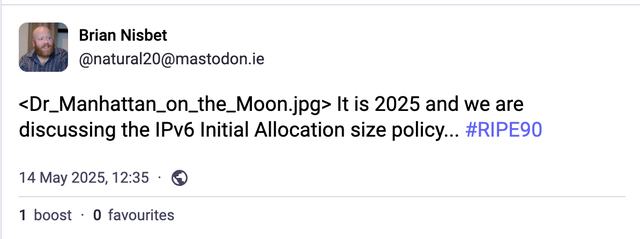
DNS WG: It’s ALWAYS DNS
Over in the side room: DNS, Doris, and a dodo. We applauded Doris Hauser as she stepped down as WG co-chair, then applauded Yevheniya Noysk who has stepped up to fill the role going forward.
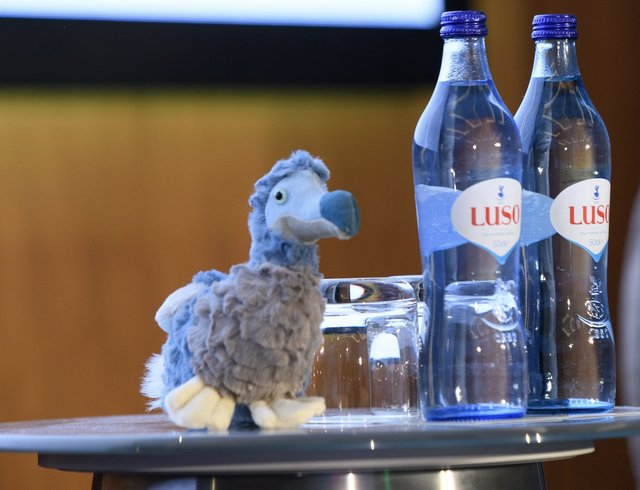
On to the presentations: Ondřej Surý got into the good, the bad and the ugly sides of post-quantum crypto for DNSSEC. Marc van der Wal took a quick look at over four million .FR domains to figure out the extent of adoption for SPF, DKIM and DMARC - the main lines of defence against email forgery and other forms of foul play - and took us on a tour of some of the curious configuration mistakes he came across along the way. Next, Asbjørn Sloth Tønnesen talked about DNS filtering - the why, the how, and the many issues that come with block pages in the age of HTTPS.
Denesh Bhabuta brought us news from the 2025 DNS Hackathon that took place at the NETNOD offices in Stockholm in March. Among the projects, Canned DNS, Babies, and idIOT (because IoT devices _are_ idIOTs) all got special commendation (for naming if nothing else!) and the award for self-appointed trouble-maker went to... Anand Buddhev (see what we did there) rounded off the session with an update on the RIPE NCC DNS services.
The session ended with an unexpected jingle, the chipperness and cheesiness of which we are afraid, dear reader, cannot be fully conveyed to you in words. Just remember: "It's ALWAYS DNS!"
IoT WG: Wait! Am I watching it, or is it watching me?
Dr. Anna Maria Mandalari’s talk went into exciting details on privacy issues for IoT devices as well as regulation compliance and questions of certification in this area. Abhishek Mishra enumerated a number of issues regarding how DNS is used in IoT devices, as well as MDNS, DoH, HTTP and IPv6 use and a call for DNS guidelines for IoT.
Michael Richardson introduced IoTSecurityFoundation.org, a “Device Identity Forum” in order to help make IoT devices safe to connect. He also introduced a proposed new IETF working group: Secure Access to TLS Local Resources (SETTLE) aimed at delivering certificates to (IoT) devices so they can be accessed with standard browsers.
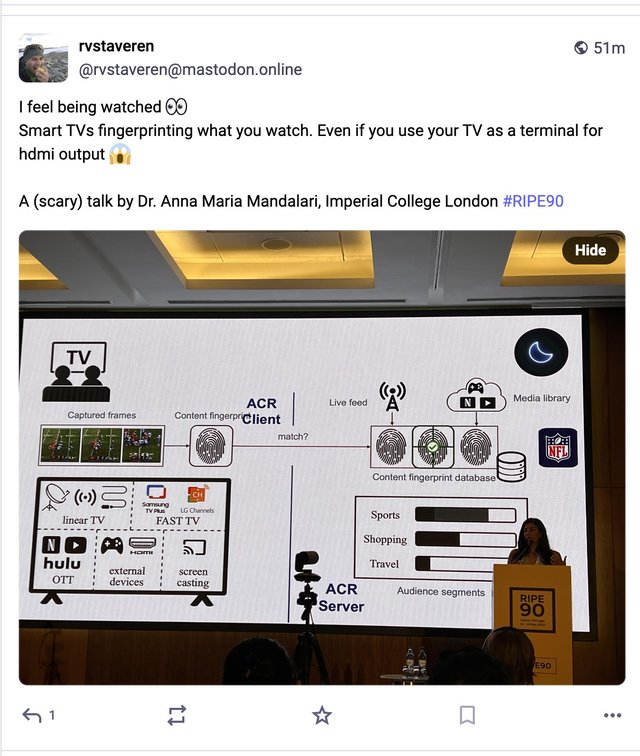
RIPE NCC Services WG: Everyone’s favourite
At the RIPE NCC Services Working Group (allegedly everyone’s favourite working group), members of RIPE NCC’s Executive Team went through the many highlights from the NCC’s work in 2024 and what’s happening this year.
Hans Petter Holen has been acting Chief Registry Officer (CRO) for the past several months, so he gave the update on what our Registry Teams have been up to in the past year (turns out, quite a lot). Hans Petter concluded his presentation by introducing the new CRO, Gabor de Wit, who was warmly welcomed by the community (look out for a green shirt to discuss the Registry matters).
Next up, Felipe Silveira Victolla gave the Technology highlights, including an update on how the RIPE NCC’s cloud strategy has been evolving in light of geopolitical developments and concerns from our members. There was a good discussion about the topic, and Felipe said the NCC would continue to discuss this topic transparently with members and community in the coming months.
Hisham Ibrahim then stepped up to give the External Engagement and Community update. It turns out we engaged in many places, with many people, in many fora, on many things in 2024, and it looks like 2025 will see more of the same. He ended with a hint that we’re on the road to RIPE 100.
Finally, Hans Petter stepped back up to tease the exciting next chapter: the RIPE NCC five-year strategy, currently simmering behind the scenes. He promised that the RIPE NCC will soon be knocking on your door for input, aiming to roll out a new roadmap by this time next year – so brace yourselves for plenty of invitations to help the RIPE NCC shape the future of the Internet!
Just when he thought he could wrap things up, the queue grew longer. And what's fuelling Hans Petter’s optimism amid all this strategic hustle, one audience member asked. Hans Peter nostalgically recalled the gripping moments when the Soviet Union was collapsing, witnessing firsthand how critical communication can transform chaos into connection. After all, the Internet isn't just about bits and bytes; it's about linking people together to build a brighter world.
And then, session over, it was time to vacate the room with a reminder to the members to come right back after the break to attend the RIPE NCC May 2025 General Meeting.
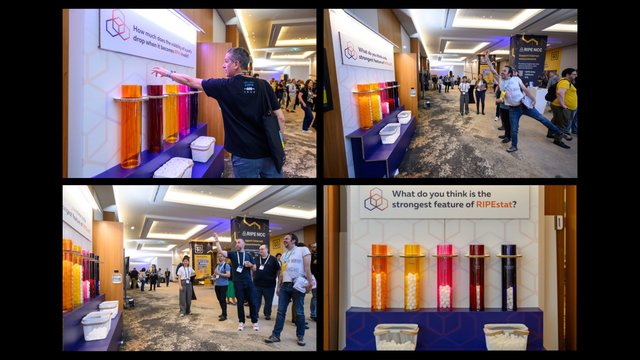
Day 2: No BBQs in the data centre please!
Bom dia! A sunny Tuesday in Lisbon and it's Day Two of RIPE 90!

Plenary
Savvas Kastanakis was the first to brave the big stage with his talk on measuring the security of critical infrastructure. He and his team are developing a BGP-based risk assessment toolbox, and found that 25% of Dutch “critical” BGP prefixes geolocate in the US.
We then heard from Leslie Daigle who is still fighting the good fight against another insidious challenge floating around the Internet - cyberattacks. Just like microplastics in the ocean, they appear to be inevitable and omnipresent, but we can all do our part by keeping our networks clean!
Alexander Asimov took us to the first break showing us why we need routing data, why we need route collectors, and why we need different applications to process, store and access BGP and BMP data.
A quick coffee break and back to it. Gerhard Stein and Thomas Weible talked about how stuff gets hot and what happens when it does. More precisely: the two shared their analysis of network reliability and measure link quality for high speed transceivers under environmental variations. Experiments not to be repeated in a datacenter included a BBQ, tinfoil, and an industrial heater!
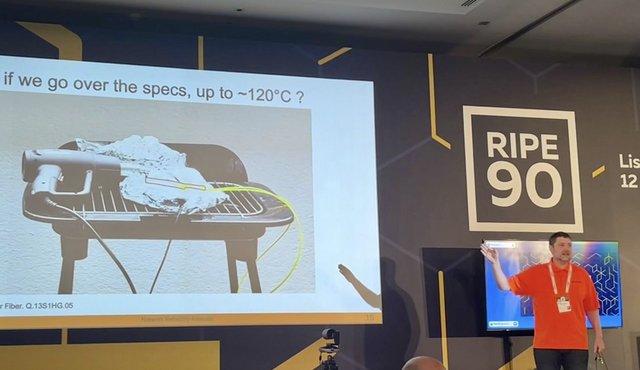
Next up, Grigorii Solovev introduced us to Annet, a system that lets you manage the configurations of an impressive array of network devices using simple Python scripting.
Maria Matejka then went on to reveal that besides being a well known and well respected developer of BIRD, she volunteers as a cook at summer camp for young Czech programmers where she also teaches networking. A nice segue into simulating networks on a laptop using Flock to create flocks of Birds (or other routers). Flock aims to be very accessible for students - e.g. nu sudo, and is used for teaching, but also features offline operations on a laptop perfect for those long haul flights.
Back from lunch, the next two talks examined the impact of the war in Ukraine on the country's Internet - specifically in terms of (de-)peering and the loss of peering infrastructure; and in terms of the massive human effort involved in maintaining connectivity despite the damage and destruction being inflicted on the physical network. A short film shown during the second talk - delivered remotely by Pavel Koroteev - brought home the determination and ingenuity of Ukrainian engineers who are working under unimaginable conditions to keep their country connected.
On to the lightning talks. Shane Kerr stepped up to show how, with nothing more than tcpdump and the will to try, you too can do random(ish) sampling of Internet packets! Maynard Koch rounded the session off nicely with a quick look at the increasing harm caused by IPv6 routing loops.
MAT WG
Today's MAT session was a whirlwind tour from encryptions lost in translation (who knew you could glean insights from Zoom calls without even peeking at the payload) to the eternal puzzle of "Who Actually Is?" behind the networks.
Julien Gamba demonstrated how even encrypted streams whisper their secrets if you pay attention to packet timings, revealing frame rates and resolutions without breaking encryption or invading privacy. Joshua Levett unveiled the detective work behind network ownership, showing that solving "WHOis" feels more Sherlock you’d think.
Nitinder Mohan took us to space with Starlink, highlighting earthly latency struggles when your nearest PoP is continents away. Add Pontus's high-speed memory-efficient lookups and Florian Wiedner's low-latency hardware magic, and today’s session was clearly packed with insights, all while keeping our calls safely encrypted and spy-proof. The session finished with Robert Kisteleki presenting updates on the RIPE NCC measurement tools: RIPEstat, RIS, and RIPE Atlas.
Security WG
Our newest Working Group, the Security Working Group, got started with their second session ever with a packed agenda, and a competition for the most snazzily-dressed attendees. Richard Leaning shared details about the RIPE NCC’s newly-launched Trust Portal and LEA Transparency report. He also welcomed representatives of the local Portuguese LEA. Our LEA participants are fairly easy to spot in the crowd as they are wearing suits and ties (yes, real ties!).
Emanuele Iovini from Europol, also in a suit and tie, spoke about Europol’s efforts to combat cybercrime. In short, while anonymity and end-to-end encryption are great for freedom and privacy for individuals, the police would actually really like to know whodunnit.
From crime, the WG turned towards malicious domains. Samaneh Tajali, ICANN, shared an analysis of maliciously registered domains, with 50% of them costing less than 2 dollars. She also shared a wall of (shame) fame – a table showing domain registrars of the registries studied. Sam Cheadle, also from ICANN, also in a suit (no tie), followed on with a talk on bulk domain registrations using APIs that are used to support large scale malicious campaigns. Their goals are effective detection, intervention and mitigation to identify batch registrations of potentially malicious domains. The domains might be cheap, but remember, crime doesn’t pay!
Diversity, Equity and Inclusion in Tech
The day wrapped up with the Diversity, Equity and Inclusion in Tech session. Maria Matejka spoke about improving accessibility at RIPE Meetings. Laura Lorenzo de Garcia asked what makes a good mentoring programme. As always, the DEI session helps make things better, and we thank everyone who takes the effort to stay on for the last session of a long day.

Day 1: Olá RIPE 90!
Ah Lisbon, city of explorers, sardines, and questionable sidewalk choices – it's good to be back! Day 1 of RIPE 90 kicks off with enthusiastic reunions, fresh conference badges, and great coffee functioning as informal but necessary life support system. Over the coming days, we'll have plenary and WG sessions filled with tasty technical and policy discussions, perhaps with a few existential ponderings about where this is all going and what it’s all for. But fear not! This easy-to-digest daily meeting blog is here to help you make sense of things, sans the overly-liberal use of em dashes, but with all the obscure references and bad puns we can stomach.
Opening plenary
Mirjam Kühne, RIPE Chair, opened the meeting by noting that her first ever RIPE Meeting was in Lisbon, back in 1994. She ran through a few aspects of the meeting - including that we’ve got two local hubs tuning in from NL and PL. Howdy! (or Hallo! as they apparently say in Holland).

Mirjam also noted that this week there would be discussions about the ongoing ICP-2 consultation. For those who don’t know, this is the global document currently being updated that governs who gets to be an RIR and how they stay recognised as one. By the time you read this, there will have been a BoF discussion on Monday evening. There will also be an update in the Address Policy WG on Wednesday and a discussion on the BoF outcomes in the RIPE Community Plenary on Thursday. The deadline for feedback on the updated ICP-2 draft is 27 May, and this one is somewhat important!
Next up, Luisa Ribeiro Lopes welcomed us to Lisbon on behalf of .PT, our local host who helped us to make all this possible. Luisa noted the city’s rich history of exploration and connection, serving for centuries as a place for different cultures to exchange ideas, and encouraged us to make the most of this opportunity to meet others and build relationships.
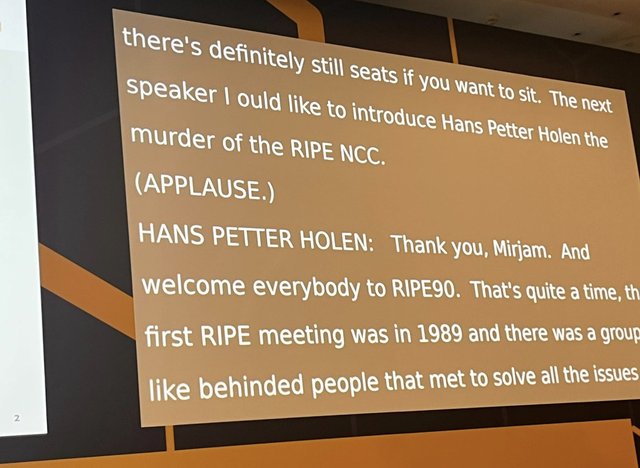
Hans Petter Holen, RIPE NCC Murder- Managing Director, welcomed everyone on behalf of the RIPE NCC and ran through some meeting logistics. Alongside the usual housekeeping, he noted that we recently published a new Trust Portal which might be of interest to the more paranoid or otherwise security-oriented folks in our community.
Dr. Maria Farrell gave a rousing start to the meeting with her proposal that we need to rewild the Internet. She used the analogy of forest monoculture (extractive, unstable, shallow ecosystem, vulnerable and prone to collapse) and contrasted this with a wild forest ecosystem (competitive, dynamic, robust, interdependent). There’s never been more of a need for a truly open, decentralised and interoperable network, but to get there we will need to change our perspective and even consider different aesthetics. She finished by saying that we are wasting our time and energy pleading with large companies to be less awful; instead we should build what we want and protect what we already have.
This was a great lead-in to Timo Hilbrink from Freedom Internet who explained how to build an ISP from scratch, with zero resources. This is a story as old as time: large telco eats small beloved ISP, small ISP launches tremendously successful crowdfunding campaign and returns as a new company more dedicated than ever to values like freedom and privacy, which made it so successful to begin with… or maybe this isn’t so common actually. Apparently the easy part was setting up a strong redundant network with great peering – the hard part was dealing with FTTH and gaining access to unbundled incumbent infrastructure, with regulators inclined to believe the tall tales of large incumbent Telcos.
Plenary
In the second Plenary session of the day, Nina Bargisen brought the community up to speed on RouteViews, the long-standing routing visibility project that’s been running since 1995. She introduced the new team who were now managing the project, shared updates to the peering policy, offered practical tips for network operators, and gave a glimpse into what’s ahead. Judging by the sea of raised hands when she asked who uses RouteViews, she was preaching to the converted.
SSH brute-forcing is the background noise of the Internet—annoying, constant, and unfortunately effective. In the next talk, Tobias Fiebig spoke on how they flipped the script, using a clever quirk in SSH’s public key challenge process to identify servers where attackers had successfully planted their keys. In other words, they found out who you gonna...scan for.
When your group chat goes down and the government has no backup plan, it’s time to grab some LoRa radios, form a club, and start rebuilding the Internet from your bike shed - because, as Valerie Aurora says, disruption is the new normal. This talk was your DIY guide to launching an Internet Resiliency Club before the next big crisis hits.
Are academic solutions actually usable in the real world? In the Lightning Talks, Aleeza Suhel Inamdar reflected on the gap between theory and practice, with academia offering plenty of proposals, while operators faced practical, operational hurdles.
In the last Lightning Talk of the day, Andrei Robachevsky outlined proposed updates to MANRS Actions and key documents like the Charter, alongside a new, more transparent development process to ensure broader community input and adaptability in a changing threat landscape.
BoF on the draft ICP-2 document / meeting of the BCOP task force
The BoF on ICP-2 started on a peaceful note, with the three NRO NC members perched at the edge of the stage to present the (ahem) snappily named "Governance Document for the Recognition, Maintenance, and Derecognition of Regional Internet Registries", which people are calling the "RIR Governance Document" for short. Working title, if you have better ideas, maybe let the NRO NC know. How much support can we get for Drafty McDraftface?
Over in the other room, the BCOP Task Force session featured three presentations. The first, quite poignant, about the resilience of Ukrainian ISPs in War and the lessons learned. Sander Steffann and Jan Žorž then wrapped up the day with two presentations. Sander on preparing guidelines on how to build a NOG and Jan on documenting the consensus process within the RIPE community.
That's a wrap on day 1, now off to see if we can meet this Liz Boa person everyone keeps mentioning.

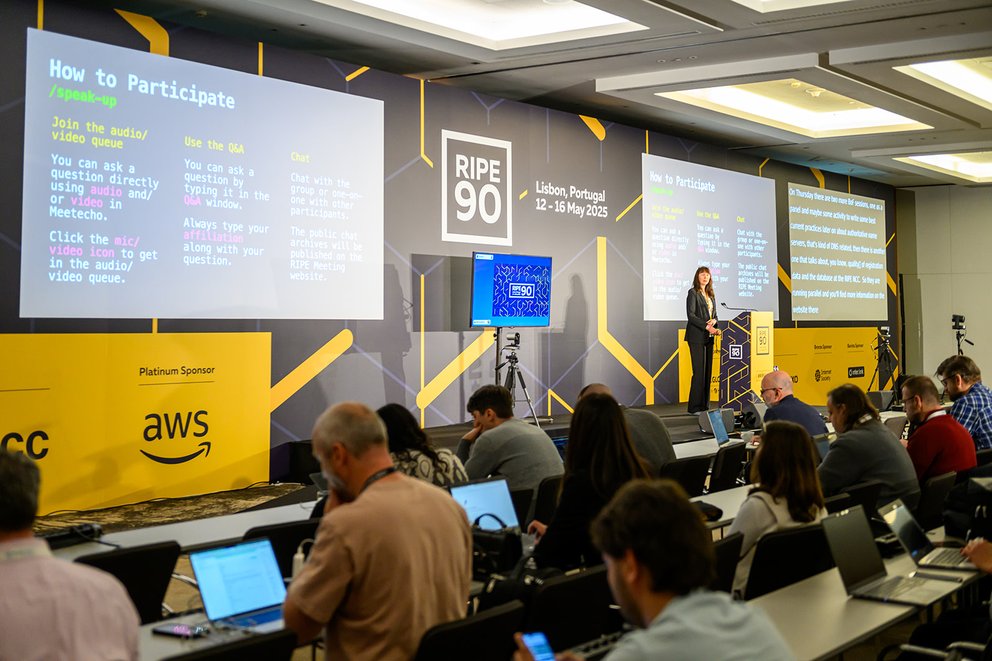
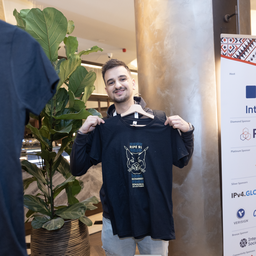
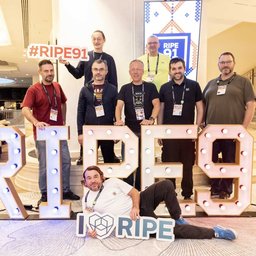

Comments 0